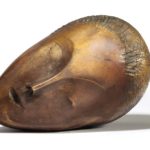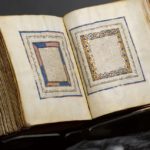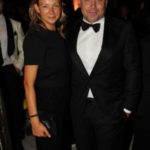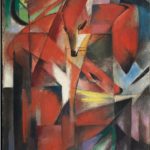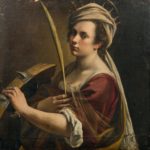
Frankfurt am Main, Germany.- The reopening of the Städel Museum’s Main River Wing with the new presentation of the Städel’s “Old Masters” (1300–1800) collection on December 5th, marks the conclusion of the comprehensive refurbishment measures in the old museum building. Developed by Prof. Dr. Jochen Sander, chief curator of the “Old Masters” collection and Deputy Director of the Städel, the new presentation benefits primarily from the recovery of the historical main axis of the Main River wing, which, starting from the central Rotunda, connects the large skylight galleries and their related cabinets. While the eastern part of the building is reserved for German, Dutch, and Flemish painting with masterpieces by Albrecht Dürer, Matthias Grünewald, Hans Holbein, and Adam Elsheimer, Rembrandt, Johannes Vermeer, Brueghel, and Peter Paul Rubens, the rooms following the cupola hall in the west mainly accommodate works by artists from Romance countries’ schools, splendidly represented by Andrea Mantegna and Sandro Botticelli, Tiepolo and Batoni, Nicolas Poussin and Chardin.
The Rotunda itself houses a small, yet qualitatively outstanding group of early Netherlandish paintings – a tribute to the crucial role played by masters like Jan van Eyck, the “Master of Flémalle,” or Rogier van der Weyden in the development of European painting north and south of the Alps.
Besides familiar and world-renowned masterpieces of the Städel, the restructured presentation of the collection also boasts numerous new acquisitions, which, as important additions, fill gaps in the Städel Museum’s collection of old masters. One of the highlights is certainly the purchased portrait of Pope Julius II by Raphael and his workshop. A portrait of Martin Luther by Lucas Cranach the Younger could be secured for the museum through the work’s acquisition by the Städelsche MuseumsVerein. Guercino’s “Virgin with Child,” dating from about 1621/22, was added to the collection as a donation by Barbara and her husband Eduard Beaucamp. During the fifteen-month conversion period, the complete old museum building (the Main River wing and the garden wing) has undergone basic refurbishment. Under the direction of the architectural office schneider+schumacher, which is also responsible for the ongoing extension of the Städel, the fire protection facilities and the barrierfree accessibility of the museum were improved. Further measures concerned the creation of a connection between the old building and the extension via a central stairway located exactly in the axis of the main entrance, as well as the reconstruction of the Metzler Hall, for which the internationally acclaimed artist Thomas Demand conceived a specific work.

Since its foundation in 1815, the Städel has been a museum of middle- and smallformat pictures. This already characterized the collection of its founder, Johann Friedrich Städel (1728–1816), but also holds true for the majority of works by old masters added to the collection in the course of the nineteenth and early twentieth centuries. Many of these works were donations or legacies left to the museum by Frankfurt citizens eager to follow in Städel’s footsteps; most of these works came from private art collections in the Main River metropolis. Such collections had already been part of the repertoire well-off patrician and middle-class Frankfurt families relied on for their self-presentation in the eighteenth century – an instrument that leaves no doubt that they ultimately followed the traditional model of the aristocracy. Yet, not even a decade would pass after the Städel Museum’s foundation before this profile determined by the Frankfurt collectors’ specific taste began to be changed. First still impeded by quarrels over the founder’s will with distant relatives, the administrators of the foundation aimed at making Städel’s private collection a public collection from 1828 on – a presentation that was to comprise exemplary works from the most important schools of European painting.
 This objective was achieved thanks to the stroke of luck that Johann David Passavant, the great art historian and connoisseur, was appointed curator (“inspector”) of the Städel – a post he held from 1841 until his death in 1861 – as well as to his successors’ collecting activities. “It was not least due to Passavant’s expertise – who had set out on his career as a member of the Nazarene movement – that the collection of old masters in the Städel achieved its level of quality which is still admired internationally today,” Prof. Dr. Jochen Sander points out. Not only key works of early Netherlandish, German and Italian painting, but also important Dutch and Flemish Baroque paintings were added to the collection assembled by Städel himself. However, representative, “princely” large formats such as Rembrandt’s “The Blinding of Samson,” Tiepolo’s “The Saints of the Crotta Family,” or Poussin’s “Landscape during a Thunderstorm with Pyramus and Thisbe” would only become part of the museum’s holdings in the course of the twentieth century. Today, the Städel Museum still finds itself confronted with the task of filling gaps in its collection of old masters mostly caused by personal preferences of taste.
This objective was achieved thanks to the stroke of luck that Johann David Passavant, the great art historian and connoisseur, was appointed curator (“inspector”) of the Städel – a post he held from 1841 until his death in 1861 – as well as to his successors’ collecting activities. “It was not least due to Passavant’s expertise – who had set out on his career as a member of the Nazarene movement – that the collection of old masters in the Städel achieved its level of quality which is still admired internationally today,” Prof. Dr. Jochen Sander points out. Not only key works of early Netherlandish, German and Italian painting, but also important Dutch and Flemish Baroque paintings were added to the collection assembled by Städel himself. However, representative, “princely” large formats such as Rembrandt’s “The Blinding of Samson,” Tiepolo’s “The Saints of the Crotta Family,” or Poussin’s “Landscape during a Thunderstorm with Pyramus and Thisbe” would only become part of the museum’s holdings in the course of the twentieth century. Today, the Städel Museum still finds itself confronted with the task of filling gaps in its collection of old masters mostly caused by personal preferences of taste.
The new hanging offers several new core themes. Right at the start, visitors will find themselves confronted with a so-called Petersburg or salon hanging – a symmetric arrangement of works closely mounted in multiple rows, one above the other – which conveys an idea of Johann Friedrich Städel’s original collection in his house on Frankfurt’s Roßmarkt. The presentation comprises most of the still extant pictures from the founder’s possession. Yet, since far more than four hundred of the five hundred paintings of the original collection were already sold with Städel’s explicit approval in the first third of the nineteenth century so that better works could be acquired, the definite appearance of the collection rooms could only be reconstructed selectively. This homage to the founder of the institution and the origins of its collection center around two portraits by Frans Hals that rank among the masterpieces of the Städel’s collection. The paintings in the museum were presented in the Petersburg fashion until the early twentieth century, by the way; the taste of the times only changed after. The stairway presentation also recalls the beginnings of the institution by confronting two monumental works by the Nazarene painters Philipp Veit and Friedrich Overbeck, who decisively influenced the Städel’s fortunes in the early nineteenth century, with a work by Carl Friedrich Lessing, whose history painting superseded the Nazarenes’ religious art. Leaving the stairway behind, visitors enter the Rotunda, where they find themselves face to face with a high-carat ensemble of early Netherlandish paintings. Comprising works by such artists as Jan van Eyck, the “Master of Flémalle,” or Rogier van der Weyden, this part of the presentation gives lively evidence of the fact that the Städel Museum boasts one of the most important collections of early Netherlandish painting in the world.

Presenting major works by Lochner, Dürer, Grünewald, Holbein, and Elsheimer, as well as Rembrandt, Vermeer, Brueghel, and Rubens, the main galleries to the right are dedicated to German and Netherlandish painting, while the various schools of Romance countries follow to the left with paintings by Mantegna, Botticelli, Tiepolo and Batoni, Poussin and Chardin. The respective lateral cabinets accommodate further, mainly middle- and small-format pictures of the contexts presented in the galleries. Thanks to the specific quality and composition of the Frankfurt old masters collection, specific new core themes continually emerge beyond mere regional groupings and schools. The gallery highlighting German painting on the eve of the Reformation with its magnificent assortment of masterpieces by Dürer, Grünewald, Cranach, Holbein, and Altdorfer not only confronts the visitor with the sacral painting of the era, but also presents itself as an extraordinary portrait gallery. The two rooms reserved for Dutch painting, whose exhibits are grouped around major works by Rembrandt and Vermeer show two obvious core themes: history painting and landscape painting. Visitors will make similar observations in the rest of the galleries and cabinets. Like the stairway presentation with its salon hanging, the two cabinets flanking the stairway in the west outline the history of the Städel Museum’s collection. Here we come upon the portraits of a Frankfurt patrician family, the von Holzhausens, which were entrusted to the museum as the last male representative’s legacy in 1923. Highcaliber works by Faber von Creuznach, Urlaub, and Ziesenis illustrate the changing character of the family’s desire for representation across the centuries, but also document the development of portrait painting between the Renaissance era and the Rococo age. Visit the museum’s website at … http://www.staedelmuseum.de

